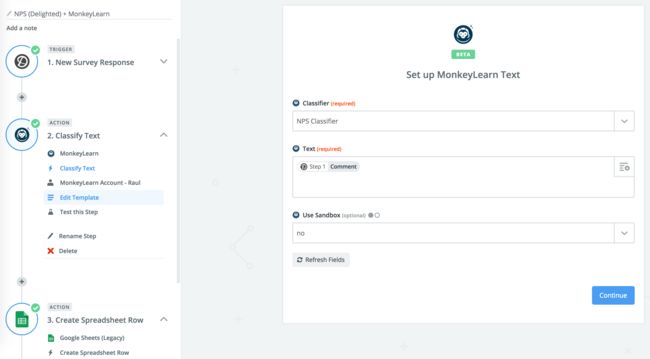MonkeyLearn + Zapier Integration
(阅者注:本文介绍如何用Zapier和MonkeyLearn将机器学习实际应用到工作当中,比如:客户咨询和投诉管理,营销邮件管理)
We are excited to announce our MonkeyLearn integration with Zapier!
Wouldn’t be amazing if you had a simple idea on how to automate a manual workflow with AI and just try it out in a couple of minutes?
Labeling your emails, tagging customer support tickets or organizing billing invoices are just a few examples of manual human processing that are time consuming and boring.
Those tasks should be automated, but they usually involve some degree of human intervention to read and understand the content.
In order to automate that, you must add a layer of Machine Learning to make machines understand that content. The limitation is that usually those small problems don’t seem to pay the effort of investing engineering resources to implement a Machine Learning solution.
As a result, it sometimes feels like the tech is here but it’s still not easily accessible for everybody. If we could make Machine Learning as easy as sending an email, all those examples of manual tasks that people do every day could be automated, which means saving a lot of time and money.
That’s the goal of this Zapier integration. Plugging MonkeyLearn AI into the apps you use every day.
What is Zapier?
Zapier is a platform that allows you to connect all your apps to work together. You can build “zaps” that are just workflows that automate a process, eg: send me a Slack message whenever someone mentions my user handle on Twitter. You can combine multiple apps, usually one triggers an event that starts the zap and performs actions on other apps.
Use Cases
Let me give you three examples where MonkeyLearn can help automating business workflows. You’ll see that the common denominator is: let’s automate repetitive human labor.
Customer Service Automation
Every time a customer service team receives a support ticket from their users and customers, it involves a considerable amount of human work.
The first step is usually reading and understanding the ticket’s topic, which then will trigger different actions like triaging (forwarding to the right agent), finding a solution and performing an action.
For companies dealing with thousands of tickets per month, saving precious time on processing each ticket means an edge. MonkeyLearn can help here.
Instead of manually reading each ticket, the first layer of action would be that MonkeyLearn analyzes the ticket subject and body. The result could be a classification according to the topic of the ticket, for example, on an e-commerce site, it would be very helpful to classify each ticket into a discrete set of buckets like billing, shipping, missing item, etc.
Or even have other classification criteria based on the particular dynamics of the business, is it a low, mid or high priority issue?
At the end of the day, having this automated process on the first layer of ticket processing can save time, reduce errors, better prioritize or even trigger auto responses in simple situations.
Outbound Sales Email Automation
On big sales teams, outbound campaigns (i.e. sending huge amounts of emails to potential customers) is a common practice. But what happens if you actually receive responses to those emails? You receive a ton of responses which may be impossible to process manually.
That means, like in the previous use case, manually reading over thousands of email responses = a lot of manual human work. Wouldn’t be great if sales representatives could spend less time reading, discarding and forwarding responses and focus on more strategical and value added tasks?
MonkeyLearn can help here. You can plug a MonkeyLearn classifier that processes each incoming email response. The classifier can automatically classify the responses into categories like:
- Interested
- Not Interested
- Unsubscribe
- Auto Responder
- Wrong Person
- Email Bounce
That means an important time saving for sales representatives on prioritizing and processing sales leads in their day to day activities.
By having this automatic pre-preprocessing sales teams can automate follow-up actions like:
- Interested: give high priority and respond right away!
- Not interested: just answer with a canned response.
- Unsubscribe: just remove from the lead prospecting list.
- Auto Responder: create a reminder to contact later.
- Email bounce: remove from lead prospecting list.
NPS Open Ended Feedback Analysis
For big companies with thousands of active users, customer feedback is vital to keep improving the product or service quality. NPS is a great method to get this feedback, with tools like Delighted, Promoter.io or Satismeter, it’s even easier.
But when users give valuable open-ended feedback, processing thousands of text responses every month can be time-consuming.
MonkeyLearn can help. You can plug a MonkeyLearn classifier that processes each open-ended response. The classifier can automatically classify the response as categories like:
- Usability
- Need time to try
- Features
- Pricing
- Customer Service
- Other
Or any particular category that makes sense in your business. Then you can automate follow-up actions like:
- Usability: forward to UX/UI.
- Features: forward to Product Manager.
- Pricing: forward to Business Dev.
- Need time to try: should you delay the time to send NPS?
The Integration
The great potential of integrating with Zapier is that now you can plug MonkeyLearn AI into the tools that you use every day.
In order to get started, just search for the MonkeyLearn app within Zapier and connect your MonkeyLearn account with your API token.
You can visit our Zapier Integration page and check out some Zap ideas.
We can’t wait to see what cool zaps will be created by users. We believe that the possibility to add Natural Language Processing into business workflows has a tremendous potential.
Hope you like it and don’t hesitate to send us suggestions. Stay tuned for cool applications that we’ll be publishing!


